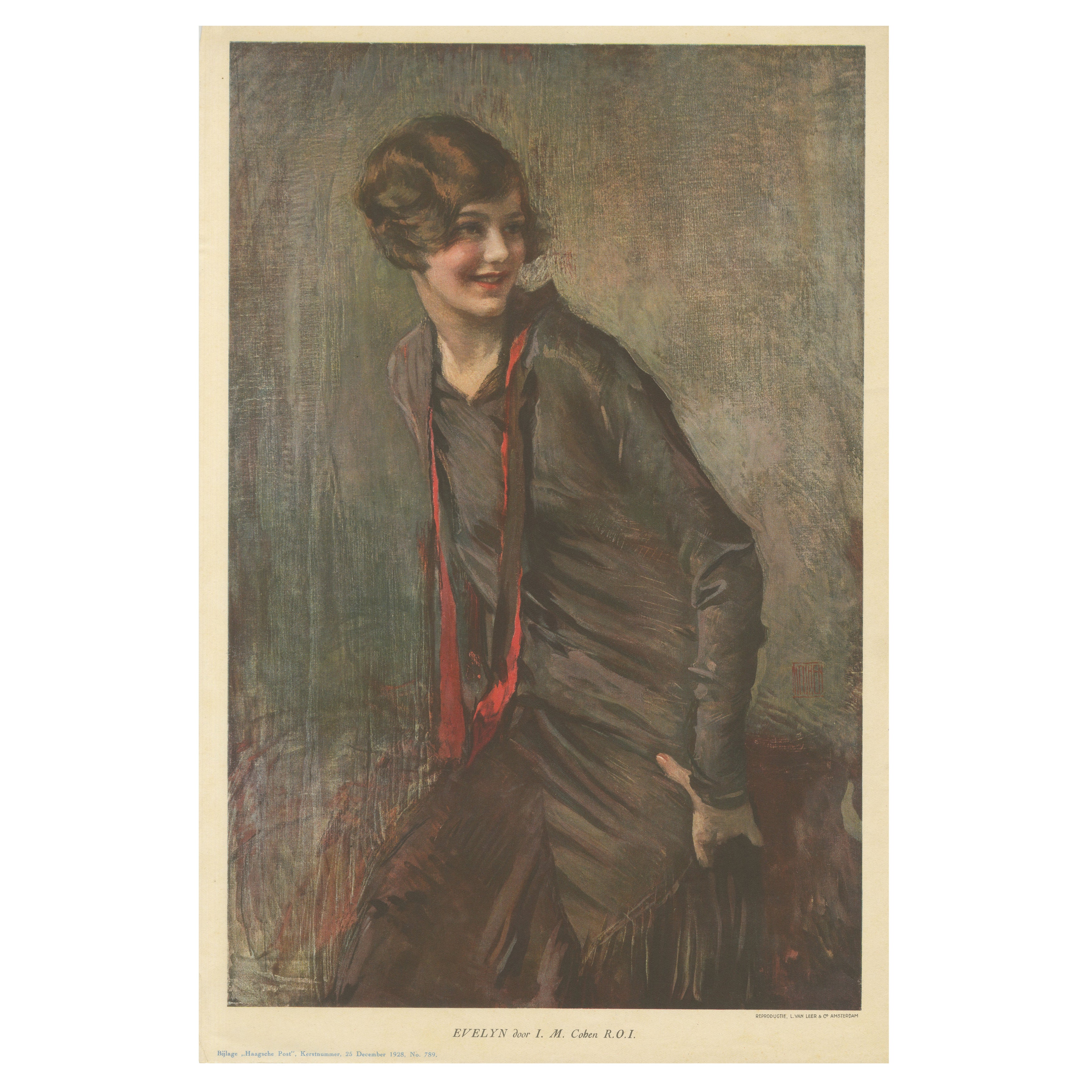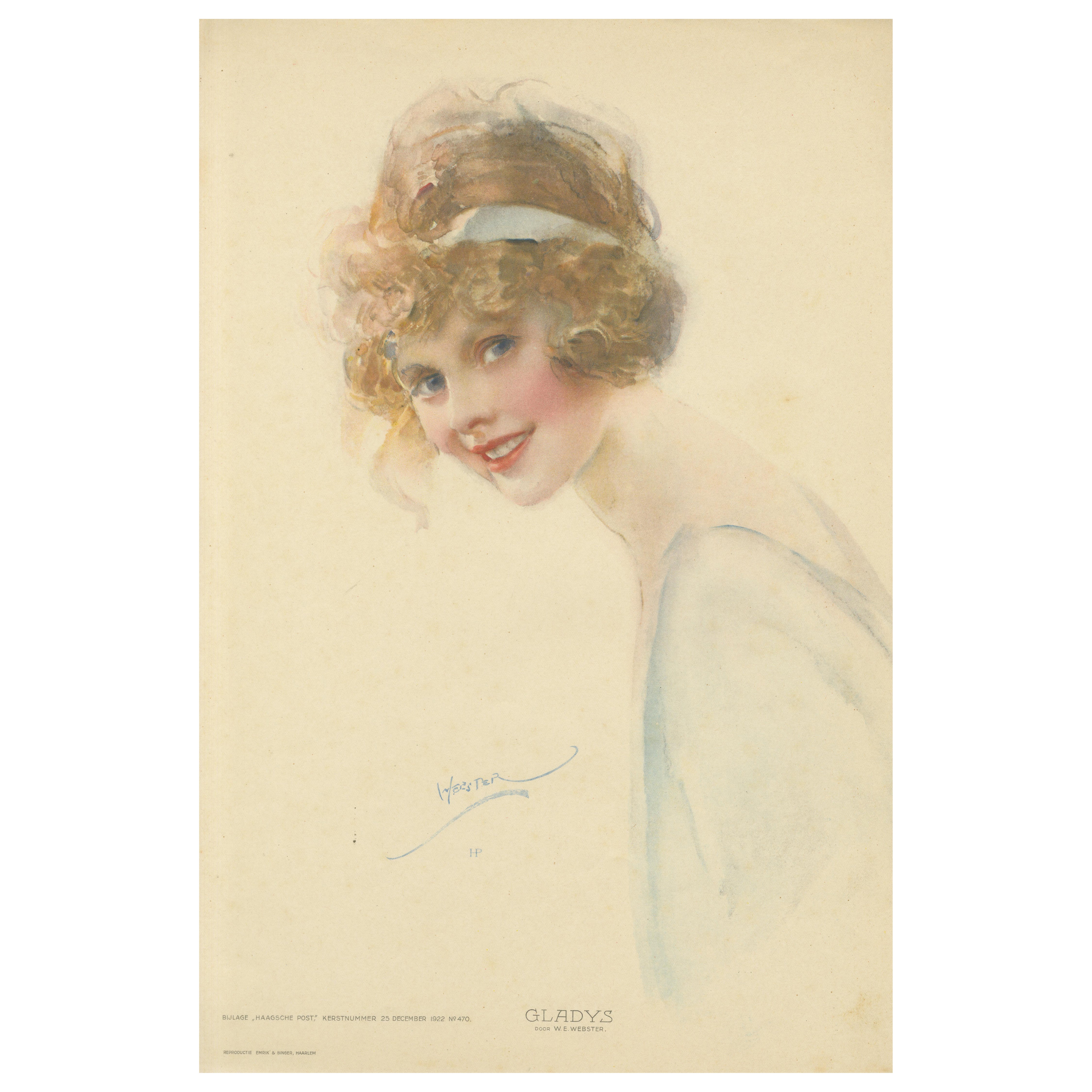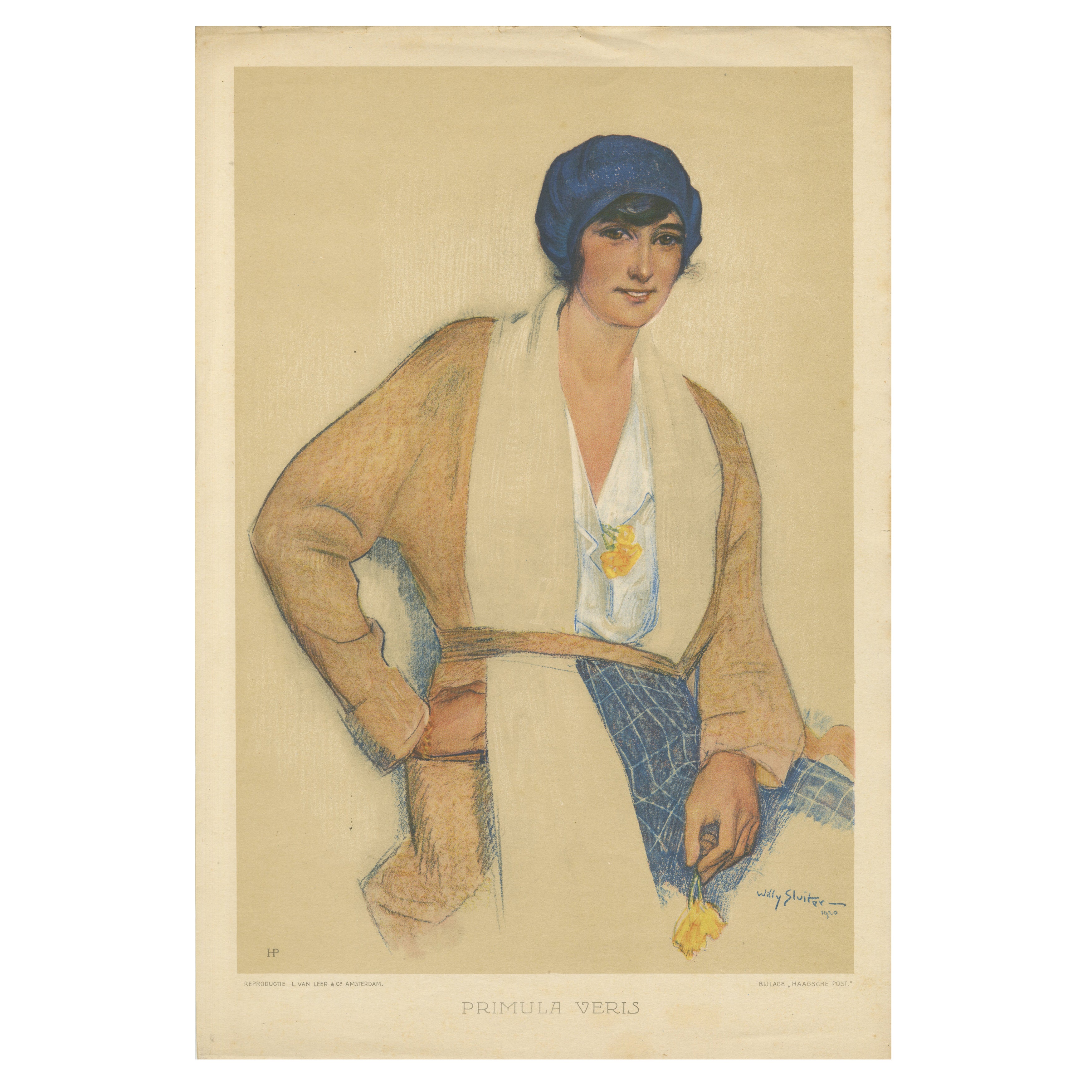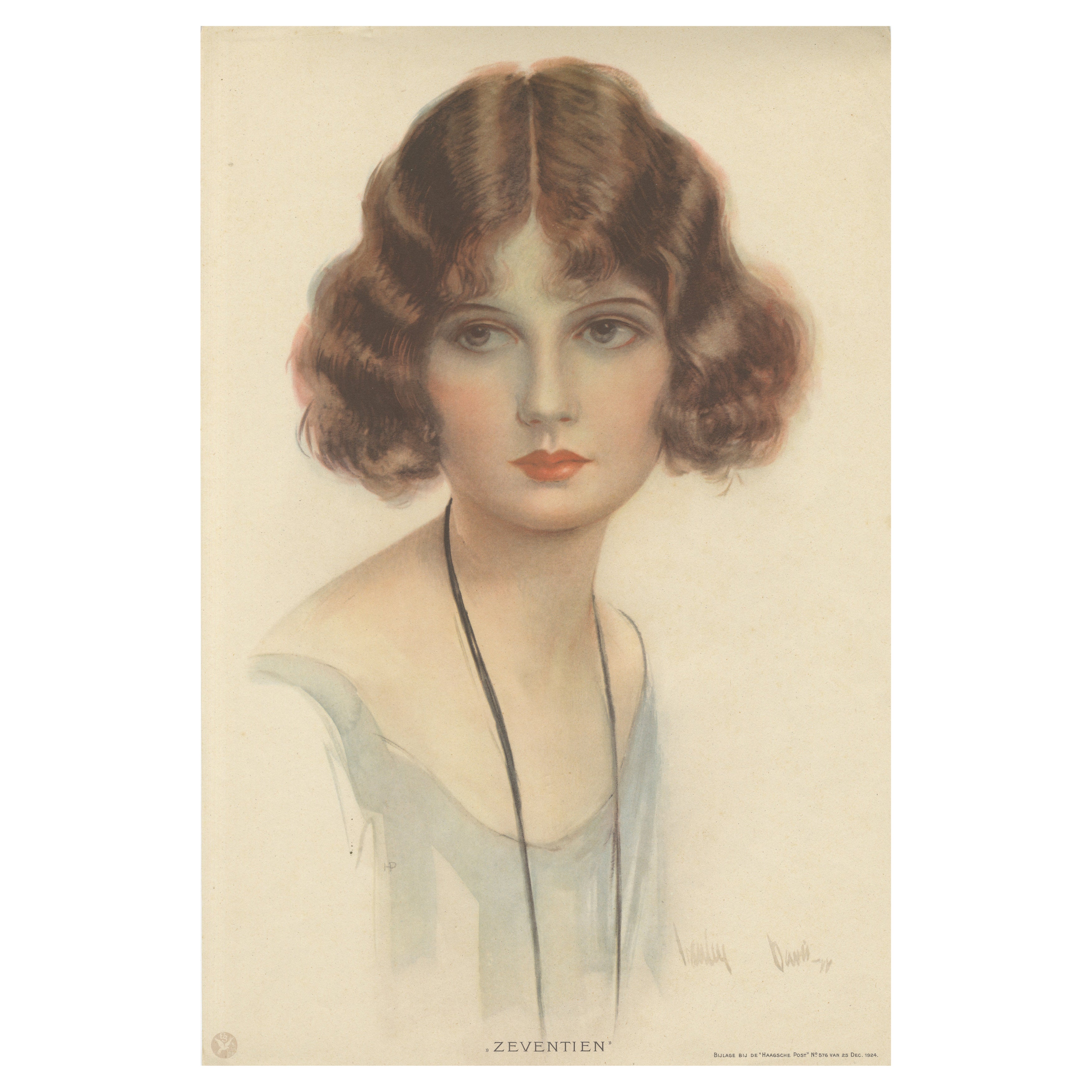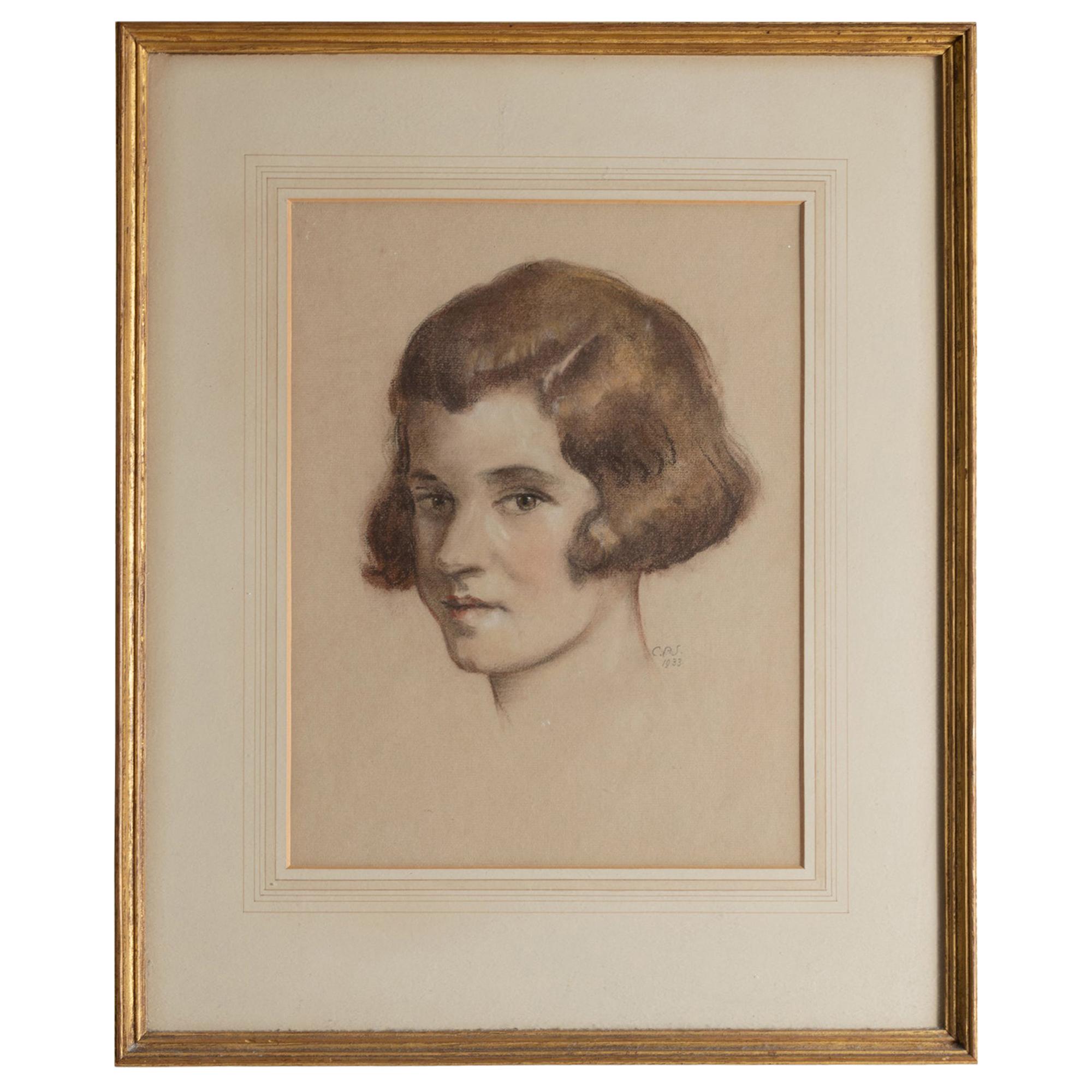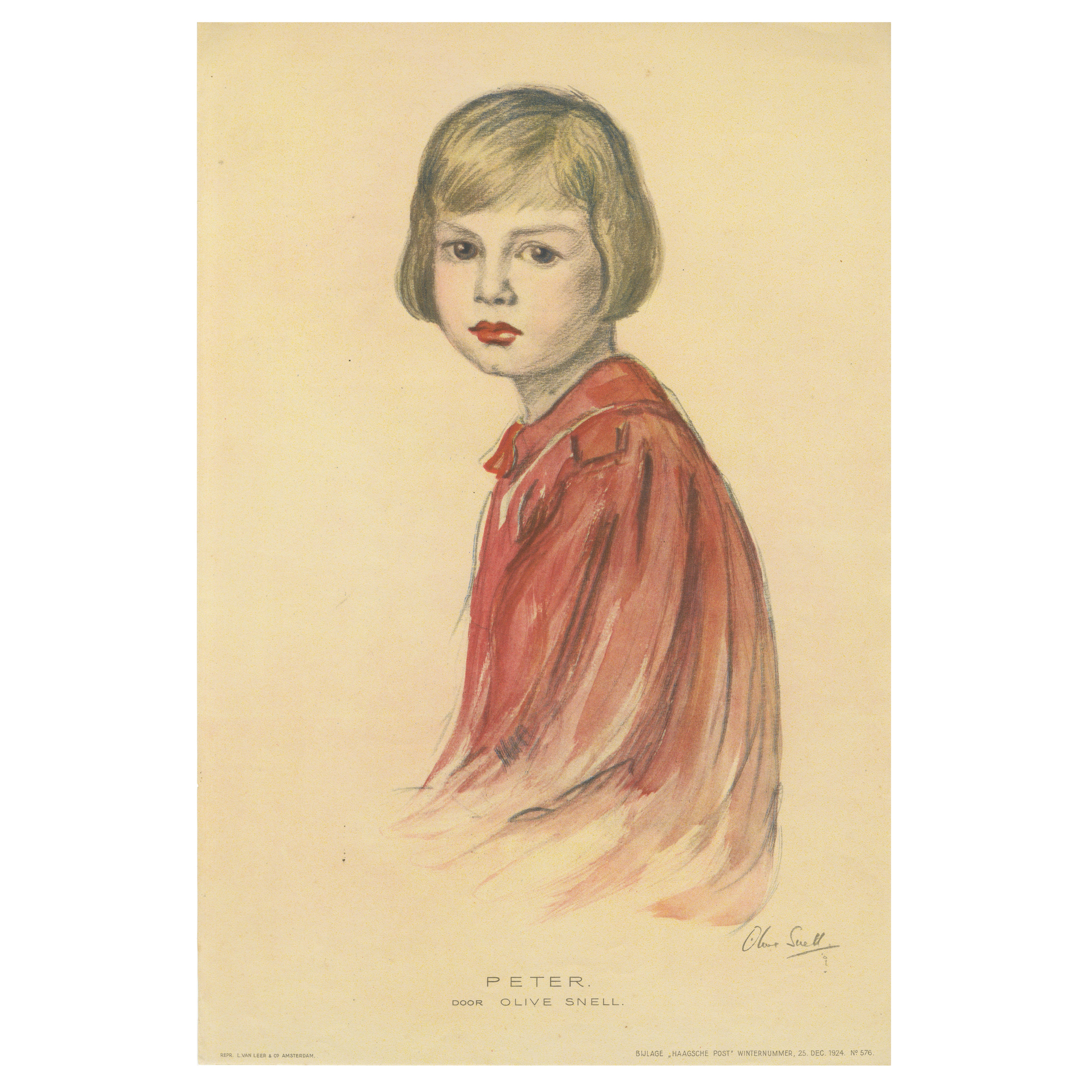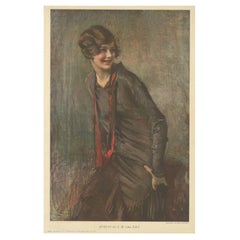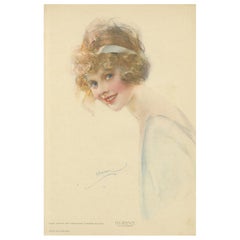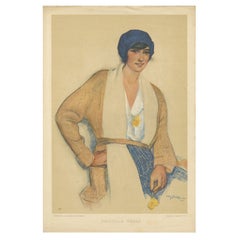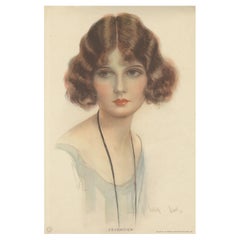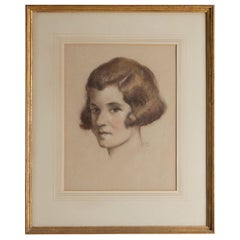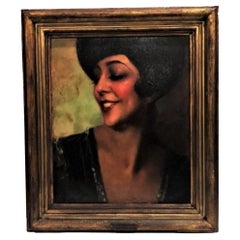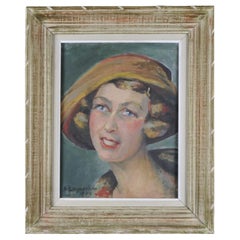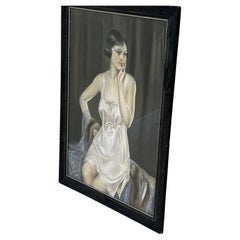Items Similar to Joyful 1920s Portrait “Vera” – Art Deco Lithograph by L. Fircsa, 1929
Want more images or videos?
Request additional images or videos from the seller
1 of 10
Joyful 1920s Portrait “Vera” – Art Deco Lithograph by L. Fircsa, 1929
$337.17
£249.47
€280
CA$466.20
A$511.83
CHF 267.02
MX$6,193.86
NOK 3,346.72
SEK 3,153.49
DKK 2,131.93
About the Item
Smiling 1920s Portrait “Vera” – Lithograph by L. Fircsa, Dutch Edition 1929
Radiant Art Deco portrait titled Vera, created by Hungarian artist L. Fircsa and published as a color lithograph in the Christmas edition of the Dutch magazine Haagsche Post, dated December 25, 1929 (No. 642). This joyful image captures a young woman with short, softly waved brown hair, flushed cheeks, and a brilliant smile—a striking representation of youthful charm and optimism at the close of the Roaring Twenties.
The sitter is shown in profile, turned slightly to the right, dressed in a warm yellow garment with a light collar. The portrait is framed by a bold blue inner border and soft grey outer margin, giving the piece a clean, graphic structure that reinforces its Art Deco design sensibility. Her bright expression and glowing skin tones evoke vitality, confidence, and the modern femininity of the period.
Signed simply “L. Fircsa” below the image, the artist was known for his sensitive and lively portraits, often featuring fashionable women of the 1920s and 1930s. His style merges subtle realism with the streamlined aesthetics of commercial illustration. The print was produced by L. van Leer & Co., Amsterdam, a prominent Dutch printer known for their work on deluxe magazine supplements and fine lithographic reproductions.
Issued as part of Haagsche Post’s annual Kerstnummer (Christmas issue), this portrait was designed to be enjoyed as a standalone art print—hence the high production values, vibrant color rendering, and elegant layout. The subject, Vera, is likely a fictional or archetypal figure chosen to embody the spirit of a new modern woman: cheerful, fashionable, and self-assured.
A standout piece for collectors of Art Deco, vintage portraiture, or Dutch magazine illustration.
Condition report:
Very good condition. Minimal wear with just faint toning in the margins. Colors remain bold and fresh. No tears or visible creases.
Framing tips:
This print is already bordered with a decorative Art Deco layout. A simple black, dark wood, or brushed silver frame would complement it well. No mat is needed unless preferred for additional space around the margins.
Technique: Lithograph
Maker: L. Fircsa, Hungary
Publisher: L. van Leer & Co., Amsterdam, for *Haagsche Post*, 1929
- Dimensions:Height: 16.82 in (42.7 cm)Width: 11.03 in (28 cm)Depth: 0.01 in (0.2 mm)
- Materials and Techniques:
- Place of Origin:
- Period:
- Date of Manufacture:1929
- Condition:Very good condition. Light age toning with only minor edge wear. No creases or tears. Paper surface clean and smooth with excellent color preservation.
- Seller Location:Langweer, NL
- Reference Number:Seller: BG-14115-51stDibs: LU3054346086552
About the Seller
5.0
Recognized Seller
These prestigious sellers are industry leaders and represent the highest echelon for item quality and design.
Platinum Seller
Premium sellers with a 4.7+ rating and 24-hour response times
Established in 2009
1stDibs seller since 2017
2,641 sales on 1stDibs
Typical response time: <1 hour
- ShippingRetrieving quote...Shipping from: Langweer, Netherlands
- Return Policy
Authenticity Guarantee
In the unlikely event there’s an issue with an item’s authenticity, contact us within 1 year for a full refund. DetailsMoney-Back Guarantee
If your item is not as described, is damaged in transit, or does not arrive, contact us within 7 days for a full refund. Details24-Hour Cancellation
You have a 24-hour grace period in which to reconsider your purchase, with no questions asked.Vetted Professional Sellers
Our world-class sellers must adhere to strict standards for service and quality, maintaining the integrity of our listings.Price-Match Guarantee
If you find that a seller listed the same item for a lower price elsewhere, we’ll match it.Trusted Global Delivery
Our best-in-class carrier network provides specialized shipping options worldwide, including custom delivery.More From This Seller
View AllStylish 1920s Portrait “Evelyn” – Art Deco Lithograph by I.M. Cohen, 1928
Located in Langweer, NL
Elegant Portrait “Evelyn” – Art Deco Print by I.M. Cohen, Haagsche Post 1928
Lively and expressive portrait titled Evelyn, created by British artist I.M. Cohen R.O.I. (Royal Institu...
Category
Early 20th Century Dutch Prints
Materials
Paper
Glamorous 1920s Art Deco Portrait “Gladys” – Lithograph by W.E. Webster
Located in Langweer, NL
Art Deco Portrait “Gladys” – W\.E. Webster Lithograph, Dutch Edition 1922
Description:
Delightful Art Deco portrait titled *Gladys*, created by British illustrator W\.E. Webster and...
Category
Early 20th Century Dutch Prints
Materials
Paper
Stylish 1920s Portrait “Primula Veris” – Lithograph by Willy Sluiter
Located in Langweer, NL
1920s Portrait “Primula Veris” – Lithograph by Willy Sluiter for Haagsche Post
Description:
Striking portrait of a young woman titled Primula Veris, drawn by renowned Dutch artist W...
Category
Early 20th Century Dutch Prints
Materials
Paper
Elegant 1920s Portrait “Zeventien” – Art Deco Lithograph by Hartley Davis
Located in Langweer, NL
Elegant 1920s Portrait “Zeventien” – Art Deco Lithograph by Hartley Davis
Refined Art Deco portrait titled Zeventien (“Seventeen”), created by ill...
Category
Early 20th Century Dutch Prints
Materials
Paper
Charming 1920s Child Portrait "Peter" by Olive Snell – Dutch Lithograph
Located in Langweer, NL
Child Portrait "Peter" – Olive Snell Lithograph, 1924 Dutch Edition
Charming early 20th-century portrait of a young child titled *Peter*, drawn by British artist Olive Snell and rep...
Category
Early 20th Century European Prints
Materials
Paper
Antique Fashion Print by Kurt Hilscher, circa 1930
Located in Langweer, NL
Signed print of Hilscher's unique take on romance. Kurt Hilscher (1904–1980) was a German commercial illustrator. Hilscher studied in 1924–1926 at the Dresden Academy of Fine Arts un...
Category
20th Century Prints
Materials
Paper
$144 Sale Price
20% Off
You May Also Like
Art Deco Portrait of a Young Woman, England, 1933
Located in London, GB
Art Deco portrait of a young woman. England, 1933.
Pencil and chalk drawing, well executed.
Initialled "C.P.S"
In vintage mount and frame.
In excellent vintage condition comm...
Category
Vintage 1930s English Art Deco Drawings
Materials
Wood, Paper
Emmanuel Fougerat, O/C Portrait of La Argentinita, ca. 1920
By Emmanuel Fougerat
Located in New York, NY
DIMENSIONS:
Height: 16.25 inches
Width: 13.5 inches
Depth: 2.25 inches
Frame width: 2.5 inches
ABOUT MODEL
Encarnación López Júlvez, known as La Argentinita (Buenos Aires, March 3, 1898 – New York, September 24, 1945) was a Spanish-Argentine flamenco dancer (bailaora), choreographer and singer. La Argentinita was considered the highest expression of this art form during that time.
López Júlvez was the daughter of Spanish immigrants in Argentina, where her father had a fabric business. While living there, two of her siblings died in a scarlet fever epidemic. Consequently, she was brought to the north coast of Spain in 1901, where she began to learn Spanish regional dances.
When she was only four years old, she started learning flamenco from Julia Castelao. Her first public performance was at the age of eight at the Teatro-Circo de San Sebastián, in the Basque Country. She chose the name "La Argentinita" in deference to the famous flamenco dancer Antonia Mercé (La Argentina).
After travelling throughout Spain as a child prodigy, she settled in Madrid to perform at Teatro La Latina, Teatro de la Comedia, Teatro de La Princesa, Teatro Apolo and Teatro Príncipe Alfonso. Her success led her to tour in Barcelona, Portugal and Paris, and then Latin America.
In the early 1920s, she returned to Spain, where she worked in Madrid. Among her early performances was the 1920 premiere of Federico García Lorca's musical play El maleficio de la mariposa as "the Butterfly". She announced her retirement in 1926, but would quickly return to the show business as part of the artistic renewal that led her to the Generation of ‘27, in which she combined flamenco, tango, bulerías and boleros. She danced to the compositions of Manuel de Falla, Joaquín Turina, Isaac Albéniz, Enrique Granados and Maurice Ravel. She helped in the development of Ballet Español.
Adapting pieces to popular tradition, she toured Europe, triumphing in Paris and Berlin and participating in the artistic movements of that time along with Spanish poets such as Rafael Alberti, Federico García Lorca, Edgar Neville and Ignacio Sanchez Mejias. Sánchez Mejías, an intellectual and bullfighter, was a married man and her lover. La Argentinita retired a second time to maintain her clandestine relationship with him. However, she would return to the stage with the aid of Sánchez Mejías, who participated in the search and employment of interpreters for her subsequent performances.
In 1931, López Júlvez and García Lorca recorded five gramophone slate records, which were accompanied by García Lorca's piano. The selection of songs was prepared, adapted and titled Colección de Canciones Populares Españolas by García Lorca. Among the ten songs were "Los cuatro muleros", "Zorongo gitano", "Anda Jaleo" and "En el Café de Chinitas".
With the beginning of the Second Spanish Republic, López Júlvez formed her own ballet company called Bailes Españoles de la Argentinita together with her sister, Pilar López Júlvez, and García Lorca. López Júlvez staged several flamenco theatrical shows, including an adaption of Falla's El amor brujo (Love, the Magician) in 1933, and Las Calles de Cádiz (The Streets of Cadiz) in 1933 and 1940.[7] She travelled through Spain and Paris, where she was recognized as one of the most important flamenco artists of her time. Her company included the flamenco figures Juana la Macarrona, La Malena, Fernanda Antúnez, Rafael Ortega and Antonio de Triana, who was her first dancing partner until the 1940s.
At the end of her tour around Spain, her lover Sánchez Mejías was gored to death in 1934 in the Manzanares bullring. She sought refuge in her work and moved to Buenos Aires to dance at the Teatro Colón; from there she embarked on a long American tour. In 1936 she achieved success in New York. Afterwards, she returned to Spain but was forced to flee the country shortly before the outbreak of the Spanish Civil War. She travelled through Morocco, France, the UK, the Netherlands, Belgium and the USA, where she remained in exile in New York. From then until her death in 1945, she developed her career and became one of the biggest stars of international dance, and even participated in movies.
In 1943, she presented the flamenco troupe El Café de Chinitas at the Metropolitan Opera House in New York, with her own choreography, texts by García Lorca, scenery by Salvador Dalí and the orchestra directed by José Iturbi. In addition, she performed at the Washington DC Watergate complex with her sister.
On May 28, 1945, she gave her last performance at the Metropolitan of the orchestral work El Capricho Español, composed in 1887 by Nikolai Rimsky-Korsakov and based on Spanish melodies. At the end of the event, she had to be admitted to a hospital, where she died on September 24 from a tumor in her abdomen. She did not want to have it operated on because she did not wish to abandon dancing. Her body was repatriated to Spain in December and buried in the Spanish capital. That same year, the company of Bailes Españoles de la Argentinita was dissolved.
Among the honors she received after her death was a plaque consecrated at the Metropolitan Opera House, positioned among the medals of Alfonso X El Sabio and La Orden de Isabel la Católica to honor her merits in the field of culture.
ABOUT ARTIST
Emmanuel Fougerat (French, 1869 – 1958) was a renowned French painter, museum curator and art historian. A former student of the Regional School of Fine Arts in Rennes, Fougerat studied in the studio of Albert Maignan and that of Jean-Paul Laurens in Paris.
He was appointed director of the Nantes School of Fine Arts and was also the founder and curator of the Museum of Fine Arts in the same city. Emmanuel Fougerat was named Chevalier of the Legion of Honor in 1912. In 1923, he was placed on temporary leave from the French State in order to carry out a mandate as director of fine arts education in the Province of Quebec, Canada; where he served as an art teacher and director of the École des beaux-arts de Montréal from 1923 to 1925.
Emmanuel Fougerat’s paintings are in the following public collections:
• Nantes Museum of Fine Arts, France.
• Museum of Modern Art in Paris, France.
• Rennes Town Hall: permanent decorations.
• Museum of Fine Arts of Saint-Nazaire (destroyed in 1944), France
• National Museum of Fine Arts of Quebec, Canada.
Emmanuel Fougerat is also the author of works on several French painters, including Albert Besnard, Paul Baudry...
Category
Vintage 1920s French Art Deco Paintings
Materials
Canvas
Lazarska Stéfania '1887-1977', Portrait of A Woman Signed and Dated 1934
Located in BARSAC, FR
Lazarska Stéfania (1887-1977) – Polish painter from the école de Paris
Beautiful portrait representing a smiling woman wearing a hairstyle and hat typical of the 1930s.
In its original Montparnasse...
Category
Vintage 1930s Polish Art Deco Paintings
Materials
Paint
Neysa McMein Illustration On Board of A Woman In Lingerie C.1920’s
By Neysa McMein
Located in Bernville, PA
Exceptional and rare Neysa McMein illustration on board of a woman in lingerie C.1920’s. Signed on bottom left corner. Some edges showing a little wear. Dimensions picture 27.5 inch...
Category
Early 20th Century American Paintings
Materials
Paint
Portrait of Flapper by C. Brosset, Signed Oil on Canvas c. 1928
By C. Brosset
Located in Atlanta, GA
Portrait of Flapper by C. Brosset, Signed Oil on Canvas c. 1928
Image Size 16"H X 14 3/4"W X 1/2"D
Overall Size 19 1/2"H X 18"W X 1 1/2"D
Image Size 16"H X 14 3/4"W X 1/2"D
Overall Size 19 1/2"H X 18"W X 1 1/2"D
Category
Swedish Paintings
Materials
Canvas
Original 1926 lithograph - Menu for the Association Artistique Le Cornet
By Fernand Louis Gottlob
Located in PARIS, FR
Very nice original lithograph that was actually a menu for the Association Artistique Le Cornet and the 245th Dinner at the Café Cardinal in 1926.
Fernand-Louis Gottlob (1873 - 1935)...
Category
1920s Art Nouveau Prints and Multiples
Materials
Lithograph, Paper
More Ways To Browse
Portrait Collar
Italian Bistro
Italian Bone Inlay
Italian Glass Hurricane
Italian Majolica Dog
Italian Mottahedeh
Italian Renaissance Cassone
Italian Zebra Sculpture
Ivory Carvings
Japan Abstract Art Midcentury
Japanese 3 Drawer Chest Of Drawers
Japanese Bronze Tiger
Japanese Buddhist Painting
Japanese Dansu
Japanese Daruma
Japanese Dog Sculpture
Japanese Fish Sculpture
Japanese Floral Bowl
